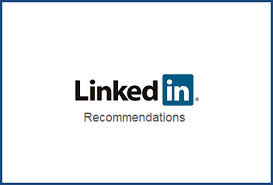Linkedin Recommendation

A Linkedin recommendation on your profile can tell your profile visitors a lot about the quality of your service and the value you can contribute if you are hired. Linkedin is a professional networking site where professionals of all fields of life and every corner of the world can create an online profile for themselves comprising of their professional experience, education and aspiration among many other things. A Linkedin profile can then be shared with others somewhat similar to a resume. However, this online resume is very much interactive and dynamic. It is interactive because it allows others to view, share, contact and recommend a profile and it’s dynamic because as it is changed and updated, the Linkedin network is able to see the most recent information about the profile including the current professional status and contact information.
A Linkedin recommendation is sort of like a professional reference which is posted to your online profile for others to see. You can also hide a recommendation but the whole point of it is to demonstrate what others think of your past performance. Another benefit of obtaining a recommendation is to obtain others’ feedback and opinion about your professional life before you actually need them. In the past, we scrambled through our contact list to get last minute professional references when we were asked by a hiring company or recruiter to provide a few, however, with a an extended list of online references, we can showcase the value we can bring to another company and avoid rushing to get professional references for a new job or contract. People rarely submit a negative recommendation online when you ask for one and most often just ignore your request if they have a negative view of you, although, they could also be busy or out of town. Obtaining an online professional feedback is also a good source of information about what your colleagues think about you, whether they have a positive or negative opinion. The good thing is that you don’t have to accept and display a negative recommendation; therefore it is a good strategy to ask for as many recommendations as possible in which case the worst possible scenario is a no reply to your request. The side benefit of requesting Linkedin recommendations from your Linkedin contacts is to know who really even cares enough about you to take the time and write one. I personally respect more those who either provide a constructive (negative) feedback or tell me that they would be glad to provide a reference offline if needed than those who just ignore the recommendation requests. But like I said, by requesting a Linkedin recommendation, you have nothing to lose and everything to gain including constructive feedback to improve yourself and information about the reliability of your network contacts.
Although writing a decent Linkedin recommendation is a difficult task, I have to admit that it gets easier and more meaningful as I continue to write for my colleagues. Initially, when I started to write online recommendations, I did not grasp the technical requirements needed to write them quickly and concisely while making sure they are reflective of my honest view of the person I was recommending. However, I’ve come to a reasonable strategy in order to quickly collect my thoughts regarding a person and put them in writing in a concise manner.
Now that we’ve established why obtaining a Linkedin recommendation is beneficial to our professional life, lets’ go over how I proceed to write a recommendation:
First, I list the positive attributes of the person I’m recommending using keywords such as punctual, creative, great organizational skills, technical, and so forth. Then, I incorporate these keywords in sentences used to describe the person. If you have a complete negative view of the person, you should not even bother writing a Linkedin recommendation because it’s a waste of every one’s time. However, certain negative and constructive opinions can be communicated offline as a way to improve your colleague. Therefore your keywords should be positive ones which can then be used to create the Linkedin recommendation. You can then incorporate these keywords into general phrases describing the person and the value he or she can bring to the new employer. You can also use powerful sentences describing a particular situation rather than using general statements such as “John has great technical skills”. A more specific statement in the same example might be something like “John used his great technical skills to improve the lagging system performance”.
While you think about the positive attributes of a person, it’s important to keep in mind the unique skills and talents that you have noticed about the person. Although, these special skills might not have been used at the workplace where you interacted with them, these unique talents may be extremely valuable assets for a future position. Therefore, don’t overlook the importance of such unique talents just because they were not used in previous positions. Make sure you stress these important skills in your recommendation because they will also serve as great feedback to the person you are recommending for finding his or her passion and life purpose.
On the flip side, if you are requesting Linkedin recommendations for yourself from your contacts, send a personalized request if possible and always thank the person for the submitted recommendation in a personalized message. You can request recommendations in bulks but you have to take the time to thank the people who have written a recommendation for you while expressing their honest opinions. Even if you don’t fully like the recommendation because of its tone, misstatements, spelling and other errors, you can still thank them while you ask for a replacement Linkedin recommendation.
Learn about managing Linkedin contacts after reading about Linkedin recommendation.








